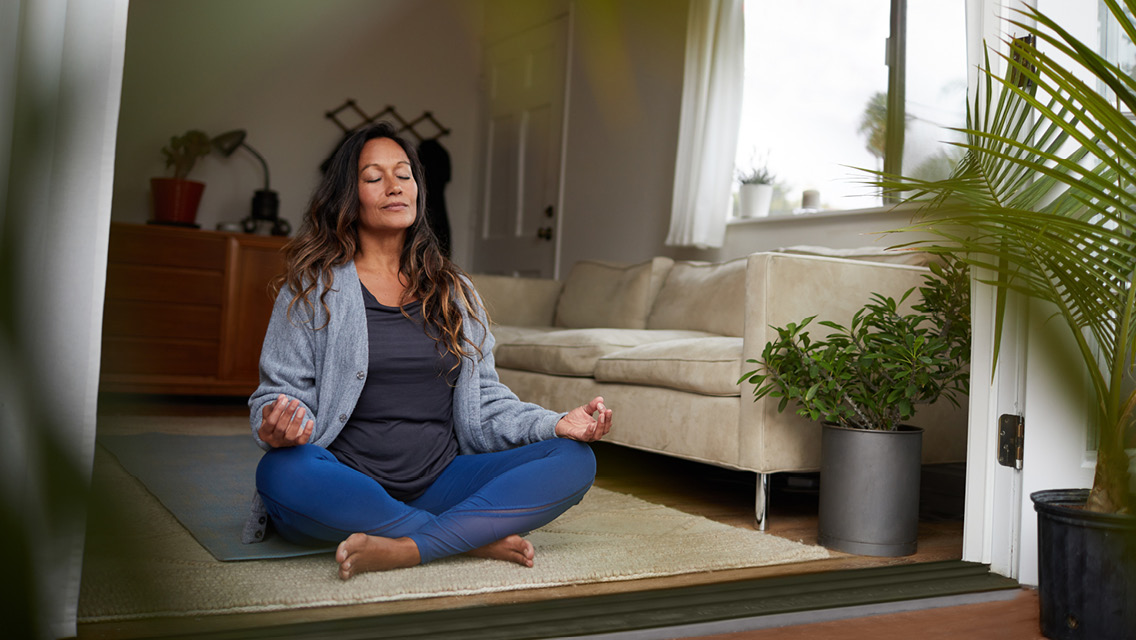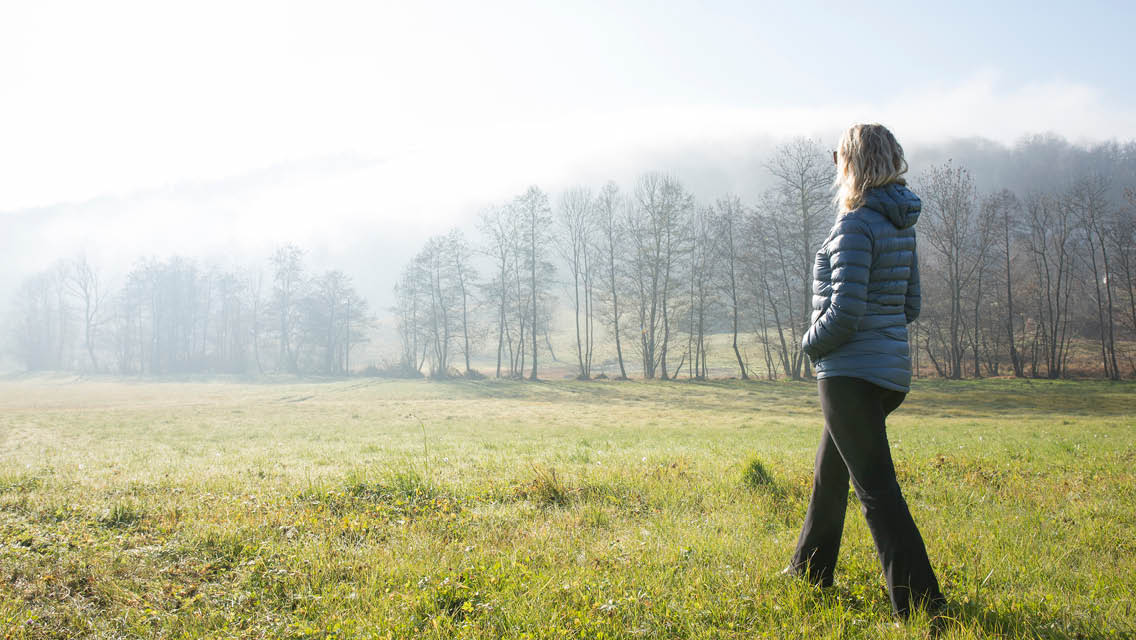Stress is unavoidable — we all experience it. In the short term, it can be a powerful motivator, but chronic stress can harm our health. So, it’s critical to develop strategies for managing stress before it switches into overdrive.
Attorney, author, and certified mindfulness practitioner Spiwe Jefferson, CMP, JD, is here to help with that. The five-minute meditation prompts and step-by-step mindfulness guides she offers in her book, Mindful in 5, are designed to help busy people reframe their perspective and reduce anxiety.
We’re teaming up with Jefferson to create this Mindful in 5 series specially curated for Experience Life readers. We’re kicking it off with this article as an introduction to Jefferson and her work.
Q&A With Spiwe Jefferson
Experience Life | What led you to write Mindful in 5?
 Spiwe Jefferson | Around 2005, a friend introduced me to mindfulness meditation, and I took lessons for years through a nonprofit religious organization rooted in Hinduism. I loved the techniques, but much of the religious context was not applicable.
Spiwe Jefferson | Around 2005, a friend introduced me to mindfulness meditation, and I took lessons for years through a nonprofit religious organization rooted in Hinduism. I loved the techniques, but much of the religious context was not applicable.
Meanwhile, life happened: I got divorced, switched jobs, relocated, lost both my parents (at different times), remarried, and began managing a blended family of five children, two dogs, and fish. Through it all, mindfulness meditation emerged as the best anchor I could have possibly had.
In addition to being a lawyer, I hold a Mindful Leader designation in mindfulness-based stress reduction (MBSR) and a certification from the Life Success Academy. In response to similar coping challenges my colleagues and friends were facing, I wrote the book I wish I’d had back then, with easy-to-implement instructions that are fun to read.
EL | How do you distinguish between mindfulness and meditation?
SJ | Meditation typically involves interiorizing your attention to increase awareness of inner consciousness. Meditative techniques discipline the mind and increase clarity and emotional stability.
Although some use mindfulness as a form of meditation, it doesn’t require closed eyes or a quiet space. Its goal is to achieve focused presence in the moment without judgment, and anyone can do it anytime.
EL | What are the benefits of combining mindfulness and meditation?
SJ | Imagine going on a road trip. Initially, you chart your course, then you refer to your GPS throughout your journey. The Mindful in 5 practice similarly combines the best of meditation and mindfulness: Set your intentions for your day first thing in the morning with at least five minutes of meditation. Use mindfulness throughout the day to remain present and anchored.
However your day unfolds, retain your power to control yourself and your responses.
EL | You describe your book, Mindful in 5, as the Who Moved My Cheese of mindfulness meditation. Why is that?
SJ | Written by Spencer Johnson, MD, Who Moved My Cheese is a book that uses characters in an entertaining allegory about how people navigate change. It’s one of my favorite books, and it inspired me to use characters to illustrate how to harness mindfulness meditation to overcome life’s challenges.
EL | Your book is divided into three seasons: Dark, Dawn, and Day. Why? What’s the significance?
SJ | Wherever you are in the world, days follow the same progression, hence Dark, Dawn, and Day. The “seasons” are loosely based on a construct called the Learning Zone Model, which German pedagogue Tom Senninger adapted from psychologist Lev Vygotsky’s Zone of Proximal Development. The construct illustrates three zones in which human beings operate and learn.
The panic zone in Senninger’s model equates to the Dark season in the book. There, an event or life transition occurs that upturns your life: a death, job loss, or something overwhelming. You’re deeply stressed and completely overwhelmed.
Dawn is the season of new possibilities, learning, and growth. It can be intimidating or adventurous.
Day is the comfort zone; life is good and you’re sailing along. Stay in Day too long, though, and life can become mundane. The goal is to maneuver effectively through Dark and toggle between Dawn and Day.
EL | What is your broader intention in writing this book and starting the Mindful in 5 movement?
SJ | There is so much anxiety and animosity in the world that we cannot control. But we can control our responses and how we show up every day. My intention is to transform the workplace and the world for the better, one mindful person at a time.
Mindfulness Meditation: A Starting Point
How following FEETS can boost your mindfulness-meditation practice.
“FEETS” is an acronym I developed as an easy-to-remember meditation tool. Whether you are a novice or are fine-tuning a long-standing practice, you can use it to establish and sustain effective meditation habits and stay consistent. (It will also come in handy as we delve deeper into this practice in future issues.) “FEETS” stands for the following:
- Find: Choose a quiet spot you can use regularly.
- Ergonomic: Sit with your spine straight and body relaxed. If you’re sitting in a chair, your thighs and feet should be parallel to the floor, with calves at 90-degree angles to your thighs. If you’re sitting on the floor, you may want to use a cushion to keep your spine erect without straining.
- Eyes: Close them to reduce distraction. If you need a focal point, concentrate on the area between your eyebrows.
- Topic: Select a topic that speaks to you, and focus on it for just a few minutes. Your thoughts will wander, but your mind will calm down with consistent practice.
- Stillness: Be still and breathe. Get used to sitting in silence.






This Post Has 7 Comments
It was an honor to collaborate with Molly, Jamie, and my friends at Experience Life on this #Mindfulin5 piece. I really hope you readers find it as helpful as I have found articles in #ExperienceLife over the years. Please share your comments about how you are using #mindfulness (or maybe trying to!) in your lives and how that’s going.
Such an insightful article! Thank you for a memorable acronym that I can use to begin my own meditation practice!
Thank you Experience Life and Spiwe Jefferson for publishing such valuable and actionable information! Over the past year I’ve applied mindfulness meditation to my everyday life and the benefits have been numerous (e.g. better sleep, greater empathy, and increased emotional resilience). Many of us have spent years developing our bodies from the shoulders down. It’s so gratifying to see Lifetime help its members strengthen that precious space between our ears. Thank you!
Outstanding article and very useful advise. We need meditation and mindfulness during these very trying times that we live in. This is a very impactful and actionable practice.
Thank you for sharing this article. Well done!
Great article and Spiwe truly lives and walks the mindful life and has inspired and I learn a lot from her
This article explains the difference between mindfulness and meditation really well. I like that mindfulness is a meditative practice accessible to anyone — regardless of religious background or affiliation. Mindful in 5 has been a great tool to support my meditation practice throughout my day.
In a world that is dominated by busyness and electronic media entertainment, there has been a departure from the helpful practice of meditation and mindfulness. As a Christian, I have found Spiwe’s article and book to be a helpful guide to help in slowing down to be more reflective , thoughtful and at ease.